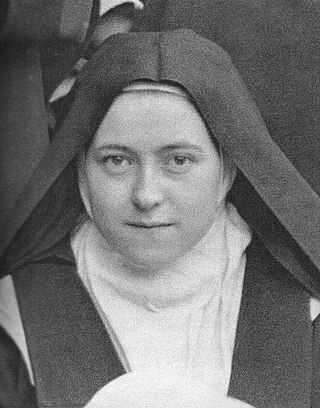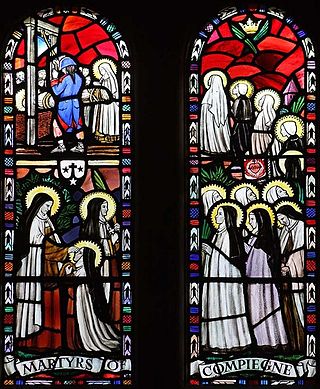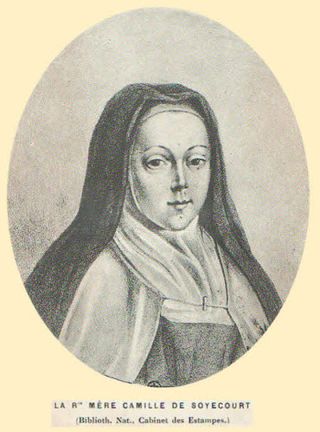
The Order of the Brothers of the Blessed Virgin Mary of Mount Carmel, known as the Carmelites or sometimes by synecdoche known simply as Carmel, is a Roman Catholic mendicant religious order for men and women. Historical records about its origin remain uncertain, but it was probably founded in the 12th century on Mount Carmel in the Crusader States. Berthold of Calabria, as well as Albert of Vercelli, have traditionally been associated with the founding of the order, but few clear records of early Carmelite history have survived. The order of Carmelite nuns was formalised in 1452.

Thérèse of Lisieux, also known as Saint Thérèse of the Child Jesus and the Holy Face, was a French Catholic Discalced Carmelite nun who is widely venerated in modern times. She is popularly known in English as the Little Flower of Jesus, or simply the Little Flower, and in French as la petite Thérèse.

High Bradfield is a rural village 6.5 miles (10 km) north-west of the centre of Sheffield in South Yorkshire, England and within the city's boundaries. The village lies just within the Peak District National Park, 1.3 miles (2 km) inside the park's north-eastern border, is at an altitude of 260 metres (850 feet) AOD, and has extensive views across Bradfield Dale towards Derwent Edge and the Dark Peak.

Worrall is a small rural village in the civil parish of Bradfield, South Yorkshire, England, 4 miles (6.5 km) north west of Sheffield city centre. It has an area of 233 hectares, and population of 1,306 as of 2006, and borders the Sheffield suburbs of Wadsley, Middlewood and Loxley to the south and east and the adjoining village of Oughtibridge to the north; to the west is a rural area extending towards the village of High Bradfield.

Annibale Maria di Francia, RCJ was an Italian Catholic priest known for founding a series of orphanages, the Rogationist Fathers and the Daughters of Divine Zeal. He has been canonized as a saint and his feast day is 1 June.

The Discalced Carmelites, known officially as the Order of the Discalced Brothers of the Blessed Virgin Mary of Mount Carmel or the Order of Discalced Carmelites, is a Catholic mendicant order with roots in the eremitic tradition of the Desert Fathers. The order was established in the 16th century, pursuant to the reform of the Carmelite Order by two Spanish saints, Teresa of Ávila (foundress) and John of the Cross (co-founder). Discalced is derived from Latin, meaning "without shoes".

The Basilica of the National Shrine of the Little Flower also called Our Lady of Mount Carmel and St. Thérèse Church is a historic Roman Catholic church, located in San Antonio, Texas, in the United States. The church is distinguished as one of 84 in the United States bearing the papal designation of "minor basilica." Despite its religious importance it is not the cathedral of the local diocese; that distinction belongs to San Fernando Cathedral.
The Third Order of Saint Francis is a third order in the Franciscan tradition of Christianity, founded by the medieval Italian Catholic friar Francis of Assisi.
The Carmelite Sisters of the Most Sacred Heart of Los Angeles is a Catholic religious institute of the Carmelite Order founded by Mother Maria Luisa Josefa of the Most Blessed Sacrament. It is based in Alhambra, California, a suburb of Los Angeles.
The Byzantine Discalced Carmelites are communities of Discalced Carmelites that operate in several Eastern Catholic Churches, namely the Bulgarian Byzantine Catholic Church, the Melkite Greek Catholic Church, the Ruthenian Greek Catholic Church, the Ordinariate for Eastern Catholics in France and the Romanian Greek Catholic Church.

The Martyrs of Compiègne were the 16 members of the Carmel of Compiègne, France: 11 Discalced Carmelite nuns, three lay sisters, and two externs. They were executed by the guillotine towards the end of the Reign of Terror, at what is now the Place de la Nation in Paris on 17 July 1794, and are venerated as beatified martyrs of the Catholic Church. Ten days after their execution, Maximilien Robespierre himself was executed, ending the Reign of Terror.[b] Their story has inspired a novella, a motion picture, a television movie, and an opera, Dialogues of the Carmelites, written by French composer Francis Poulenc.

Regina Coeli Monastery is a historic building located in Bettendorf, Iowa, United States. It has been listed on the National Register of Historic Places since 1994. The building currently houses an addictions rehabilitation facility called The Abbey Center. The Discalced Carmelite nuns who built the building relocated to a new monastery in Eldridge, Iowa in 1975. The monastery was originally established in Davenport, Iowa by James Davis of the Catholic Diocese of Davenport.

The century old Carmel Higher Secondary School is a private Catholic secondary school for boys, located at Carmel Nagar, Ramanputhoor, in Nagercoil, in the Kanyakumari District, in the state of Tamil Nadu, India.
Carmelite Monastery, Wolverhampton is a monastic house at Poplar Road, Penn Fields, Wolverhampton, in the West Midlands, England. It was founded in 1922 by sisters from the Most Holy Trinity Monastery of Notting Hill, London.

The National Shrine & Museum of St. Therese in Darien, Illinois is a Roman Catholic shrine dedicated to St. Thérèse of the Child Jesus and the Holy Face. The Shrine is a part of the Aylesford Carmelite campus, run by the Carmelite Order, Province of the Most Pure Heart of Mary. The National Shrine & Museum of St. Therese is supported and served by the Society of the Little Flower, a religious organization dedicated to promoting devotion to St. Therese of Lisieux.
St. Thomas–St. Vincent Orphanage was an orphanage located in Anchorage, Kentucky, best known for allegations of child sexual and physical abuse by one priest, seven nuns, and five laymen, between the 1930s and 1970s. It opened with the merger of St. Thomas Orphanage and St. Vincent Orphanage in 1955 and closed in 1983 as a result of rising costs and increased government services for orphans.

Camille de Soyécourt (1757–1849) or Thérèse Camille de l'Enfant-Jésus was a French Discalced Carmelite nun who restored the order in France after the French Revolution.














